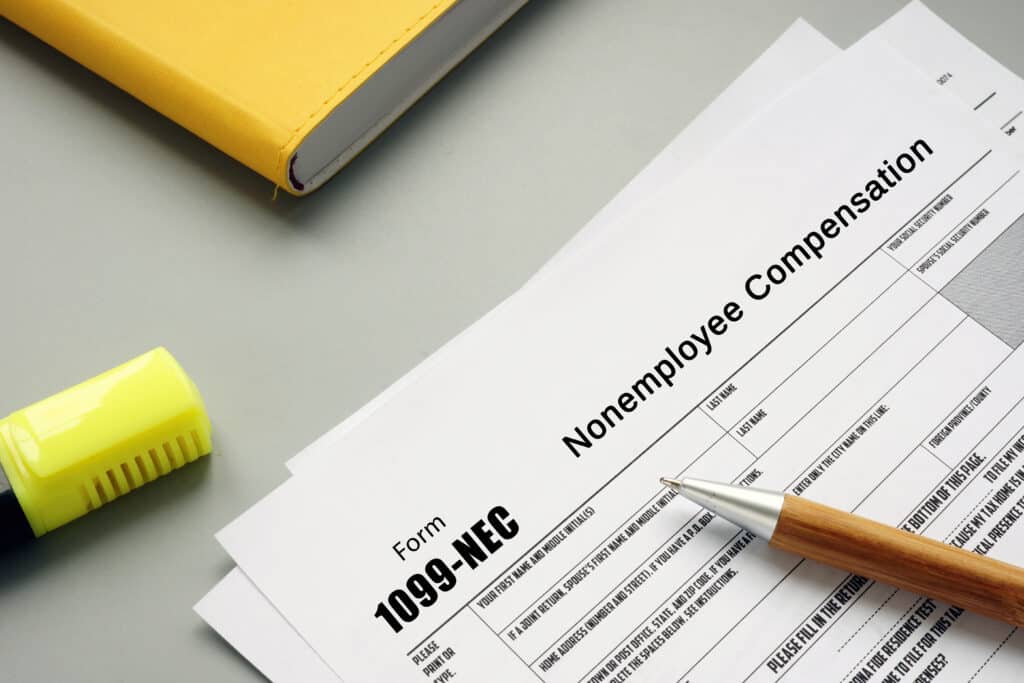Form 1099-NEC: Common Mistakes to Avoid for Error-Free Filing

The IRS Form 1099-NEC, or Nonemployee Compensation form, is a tax form that businesses use to report payments made to individuals who are not their employees. This includes independent contractors, freelancers, and service providers.
If your business pays $600 or more to someone who isn’t on your payroll, you must provide them with form 1099-NEC. This applies to payments for services provided by individuals, single-member limited liability companies (LLC), partnerships, or LLCs taxed as partnerships.
Additionally, if you withhold federal income tax from any nonemployee’s payment, regardless of the amount, you must report it using a nonemployee compensation form.
What Information Does the 1099-NEC Include?
The nonemployee compensation form contains essential information you need to report to the IRS and the recipient. Here’s what you’ll find on the form:
- Payer Information: This section includes your business name, address, and taxpayer identification number (TIN).
- Recipient Information: Here, you’ll provide the payee’s name, address, and TIN.
- Nonemployee Compensation: Box 1 reports the total amount you paid to the recipient for their services.
- Federal Income Tax Withholding: If you withheld any federal income tax from the payments made to the recipient, it goes in box 4.
- State Tax Withholding: Similarly, if you withheld any state income tax, record it in Box 5. Not all states require tax withholding, so check your state’s regulations.
When to File the 1099-NEC
To comply with IRS rules, you need to send the 1099-NEC forms to both the payee and the IRS by January 31. If it falls on a weekend, you have until the next business day. You can use paper or electronic filing, but make sure you file on time, otherwise, the IRS may impose penalties for late filing.
Common Mistakes to Avoid
When handling the 1099-NEC, it’s important to be mindful of potential errors that might result in IRS issues or fines. Here are five mistakes our clients often make when filling out the form:
- Missing the due date
You must send copies of the form to your payees and the IRS by January 31. You may face penalties when you don’t file the form on time.
- Getting the information wrong
Be careful with the details. Make sure everything on the form is correct, especially the taxpayer identification number. Mistakes can cause delays and fines.
- Failing to issue the form when required
If you paid a non-employee $600 or more for their service, you need to provide them a 1099-NEC. However, if you’re still unsure whether you need to complete the form, you can contact us for help and guidance.
- Not reconciling totals
Before you submit the form, double-check that the amounts reported in Box 1 match your business records. Any discrepancies can raise red flags from the IRS.
- Using the wrong form
Mixing up forms is a common mistake. But don’t get confused. Form 1099-NEC is only for reporting money you paid to non-employees for their work. If you need to report other types of income, like rent or prizes, use Form 1099-MISC instead.
Correcting Errors on Form 1099-NEC
Before you can correct a mistake on a Form 1099-NEC, you first need to identify the error. There are two main types of errors:
- Type 1 Errors: These errors involve issues with incorrect payment amounts, wrong codes or checkboxes, or filing a form when it shouldn’t have been filed.
- Type 2 Errors: These errors include incorrect payer information, such as the wrong payer or payee information including taxpayer ID number, or preparing the wrong form such as filing a 1099-MISC instead of a 1099-NEC).
To correct Type 1 errors, follow these steps:
- Fill out a new Form 1099-NEC with the corrected information, including the right amount, code, and checkbox.
- Check the “CORRECTED” box located at the top of the form.
- Provide the corrected form to the recipient.
- Prepare a red Copy A to send to the IRS along with transmittal Form 1096.
To correct Type 2 errors, you’ll need to take two steps:
- Prepare a new Form 1099-NEC with the exact same payer and recipient information as the originally filed form. However, set all the amounts on the form to zeros and check the “CORRECTED” box.
- Create a new Form 1099-NEC with the correct payer and recipient information as if you were filing it for the first time (not as a corrected form).
- Provide both the corrected and new original forms to the recipient.
- Prepare a red Copy A to send to the IRS with the transmittal Form 1096. However, do not include a copy of the original return.
Conclusion
The 1099-NEC form plays a vital role in ensuring that individuals and businesses report their income accurately to the IRS. It helps the IRS match the income reported by recipients with what payers have reported. This prevents tax evasion and ensures that everyone pays their fair share of taxes.
If you need assistance with Form 1099-NEC or other tax-related matters, don’t stress! We’re here to help. We specialize in helping businesses and individuals navigate the intricacies of tax reporting. We’ll provide expert guidance, answer your questions, and make sure you meet your tax obligations correctly and on time.
Don’t risk fines and penalties—contact us now to schedule a free confidential consultation with our expert team.


